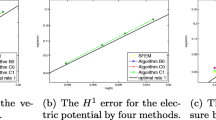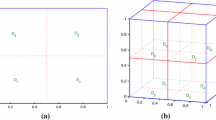Abstract
In this paper, we propose two-level coupled correction and decoupled parallel correction finite element methods for solving the stationary magnetohydrodynamics (MHD) equations. We prove the error estimates for the methods which show that if coarse mesh size \((H)\) and fine mesh size \((h)\) satisfy the relation \(H=O(\sqrt{h})\), the methods provide optimal convergence rates. Further, we study the dependence of the errors of the methods on parameters. Numerically, investigations for 2D/3D Hartmann flows with different physical parameters are conducted to validate theoretical analyses, which show the efficiency of the methods to solve the MHD problems.
Similar content being viewed by others

References
Badia, S., Codina, R.: A nodal-based finite element approximation of the maxwell problem suitable for singular solutions. SIAM J. Numer. Anal. 50, 398–417 (2012)
Badia, S., Codina, R., Planas, R.: On an unconditionally convergent stabilized finite element approximation of resistive magnetohydrodynamics. J. Comput. Phys. 234, 399–416 (2013)
Salah, N., Soulaimani, A., Habashi, W.: A finite element method for magnetohydrodynamics. Comput. Methods Appl. Mech. Eng. 190, 5867–5892 (2001)
Bonito, A., Guermond, J.: Approximation of the eigenvalue problem for the time harmonic maxwell system by continuous lagrange finite elements. Math. Comput. 80, 1887–1910 (2011)
Cao, C., Wu, J.: Two regularity criteria for the 3D MHD equations. J. Differ. Equ. 248, 2263–2274 (2010)
Codina, R., Silva, N.: Stabilized finite element approximation of the stationary magnetohydrodynamics equations. Comput. Mech. 38, 344–355 (2006)
Gerbeau, J.: Probl\(\grave{\text{ e }}\)mes math\(\acute{\text{ e }}\)matiques et num\(\acute{\text{ e }}\)riques pos\(\acute{\text{ e }}\)s par la mod\(\acute{\text{ e }}\)lisation de l’\(\acute{\text{ e }}\)lectrolyse de l’aluminium, Ph.D. Thesis, \(\acute{\text{ E }}\)cole Nationale des Ponts et Chauss\(\acute{\text{ e }}\)es (1998)
Gerbeau, J.: A stabilized finite element method for the incompressible magnetohydrodynamic equations. Numer. Math. 87, 83–111 (2000)
Gerbeau, J., Le Bris, C., Lelievre, T.: Mathematical Methods for the Magnetohydrodynamics of Liquid Metals. Oxford University Press, Oxford (2006)
Girault, V., Lions, J.L.: Two-grid finite element scheme for the steady Navier-Stokes Equations in polyhedra. Portugal. Math. 58, 25–57 (2001)
Girault, V., Lions, J.L.: Two-grid finite element scheme for the transient Navier-Stokes problem. Math. Model. Numer. Anal. 35, 945–980 (2001)
Girault, V., Raviart, P.A.: Finite Element Methods for Navier–Stokes Equations. Springer, NewYork (1986)
Greif, C., Li, D., Schötzau, D., Wei, X.: A mixed finite element method with exactly divergence-free velocities for incompressible magnetohydrodynamics. Comput. Methods Appl. Mech. Eng. 199, 2840–2855 (2010)
Gunzburger, M.D., Meir, A.J., Peterson, J.P.: On the existence, uniqueness, and finite element approximation of solutions of the equations of stationary, incompressible magnetohydrodynamics. Math. Comput. 56, 523–563 (1991)
Hasler, U., Schneebeli, A., Schötzau, D.: Mixed finite element approximation of incompressible MHD problems based on weighted regularization. Appl. Numer. Math. 51, 19–45 (2004)
He, C., Wang, Y.: On the regularity criteria for weak solutions to the magnetohydrodynamic equations. J. Differ. Equ. 238, 1–17 (2007)
He, Y.: Unconditioanal convergence of the Euler semi-implicit scheme for the 3D incompressible MHD equations. IMA J Numer Anal (2014). doi:10.1093/imanum/dru015
He, Y.: Two-level method based on finite element and Crank-Nicolson extrapolation for the time-dependent Navier–Stokes equations. SIAM J. Numer. Anal. 41, 1263–1285 (2003)
He, Y., Li, K.: Two-level stabilized finite element methods for the steady Navier–Stokes problem. Computing 74, 337–351 (2005)
He, Y., Wang, A.: A simplified two-level for the steady Navier–Stokes equations. Comput. Methods Appl. Mech. Eng. 197, 1568–1576 (2008)
Heywood, J., Rannacher, R.: Finite element approximation of the nonstationary Navier–Stokes problem. I. Regularityof solutions and second-order error estimates for spatial discretization. SIAM J. Numer. Anal. 19, 275–311 (1982)
Houston, P., Schötzau, D., Wei, X.: A mixed DG method for linearized incompressible magnetohydrodynamics. J. Sci. Comput. 40, 281–314 (2009)
Layton, W.: A two level discretization method for the Navier–Stokes equations. Comput. Math. Appl. 5, 33–38 (1993)
Layton, W., Leferink, H.: Two-level Picard and modified Picard methods for the Navier–Stokes equations. Appl. Math. Comput. 69, 263–274 (1995)
Layton, W., Lenferink, H., Peterson, J.: A two-level Newton finite element algorithm for approximating electrically conducting incompressible fluid flows. Comput. Math. Appl. 28, 21–31 (1994)
Layton, W., Meir, A.J., Schmidtz, P.G.: A two-level discretization method for the stationary MHD equations. Electron. Trans. Numer. Anal. 6, 198–210 (1997)
Lifschitz, A.: Magnetohydrodynamics and Spectral Theory. Kluwer, Dordrecht (1989)
Meir, A.J., Schmidt, P.G.: Analysis and numerical approximation of a stationary MHD flow problem with nonideal boundary. SIAM J. Numer. Anal. 36, 1304–1332 (1999)
Priest, E., Hood, A.: Advances in Solar System Magnetohydrodynamics. Cambridge University Press, Cambridge (1991)
Prohl, A.: Convergent finite element discretizations of the nonstationary incompressible magnetohydrodynamics system. ESAIM. Math. Model. Numer. Anal. 42, 1065–1087 (2008)
Schonbek, M., Schonbek, T., Söli, E.: Large-time behaviour of solutions to the magnetohydrodynamics equations. Math. Ann. 304, 717–756 (1996)
Schötzau, D.: Mixed finite element methods for stationary incompressible magnetohydrodynamics. Numer. Math. 96, 771–800 (2004)
Sermange, M., Temam, R.: Some mathematical questions related to the MHD equations. Commun. Pure Appl. Math. 36, 635–664 (1983)
Southwell, R.: Stress calculation in frameworks by the method of systematic relaxation of constraints. I.II. Proc. Roy. Soc. Lond. Ser. A 15, 56–95 (1935)
Xu, J.: A novel two two-grid method for semilinear elliptic equations. SIAM J. Sci. Comput. 15, 231–237 (1994)
Xu, J.: Two-grid discretization techniques for linear and nonlinear PDEs. SIAM J. Numer. Anal. 33, 1759–1777 (1996)
Acknowledgments
This study is subsidized by the NSFs of China (No. 11271298, No. 11371289 and No. 11371289). The authors would like to thank the editor and referees for their valuable comments and suggestions which helped us improve the quality of this paper.
Author information
Authors and Affiliations
Corresponding author
Appendix
Appendix
Proof of Theorem 1
We define a function space
For \(\forall ({\mathbf {w}},{\mathbf {d}}) \in Z,\) the linear equations: solving \({\mathbf {u}} \in {\mathbf {H}}^{1}_{0}(\varOmega ), {\mathbf {b}} \in {\mathbf {H}}^{1}_{n}(\varOmega )\) and \(p \in L^{2}_{0}(\varOmega )\) from
\( \forall ({\mathbf {v}}, {\mathbf {c}}) \in \mathbf {H}_{0}^{1}(\varOmega ) \times \mathbf {H}_{n}^{1}{(\varOmega )}, q \in L_{0}^{2}(\varOmega ),\) admit a unique solution \(({\mathbf {u}}, {\mathbf {b}} ) \in Z\) and \(p \in L^{2}_{0}(\varOmega )\) satisfying
For details, see Part I. Corollary 4.1 in [12]. We define a map
Supposing \(\Phi ({\mathbf {w}}_{i}, {\mathbf {d}}_{i})=({\mathbf {u}}_{i}, {\mathbf {b}}_{i}), i=1,2\) and using (9), (10), we have
Thus,
By the assumption in the Theorem, we know the map \(\Phi \) is a contraction map from \(Z\) to \(Z.\) Using Banach contraction mapping principle, the map \(\Phi \) admits one unique fixed point in \(Z,\) which is the unique solution of (4). \(\square \)
Proof of Theorem 3
The existence, uniqueness and \(H^{1}\) stability of discrete solution can be proved similar to Theorem 1. We only prove the error estimate (24).
Let \({\mathbf {e}}_{u}= R({\mathbf {u}},p)- {\mathbf {u}}_{h}, {\mathbf {e}}_{b}= \varLambda {\mathbf {b}}-{\mathbf {b}}_{h}, e_{p}= Q({\mathbf {u}},p)-p.\) The problem (4) subtracting problem (18) gives the error equation:
for all \(({\mathbf {v}}_{h}, q_{h}, {\mathbf {c}}_{h}) \in V_{h}\times Q_{h} \times C_{h}.\) By this error equation, we have for all \(({\mathbf {v}}_{h}, q_{h}, {\mathbf {c}}_{h}) \in V_{h}\times Q_{h} \times C_{h},\)
Taking \({\mathbf {v}}_{h}= {\mathbf {e}}_{u}, {\mathbf {c}}_{h}={\mathbf {e}}_{b}, q_{h}=e_{p},\) by (11) we obtain
Using H \(\ddot{o}\) lder inequality, Sobolev inequalities and inverse inequality, the right hand side of (49) can be estimated as follows:
By (9), (10) and (14), the left hand side can be estimated as follows:
Combing (50) with (51), and using (20), (22), (23), (15), we get
Thus, we deduce that
Then, by triangle inequality and (22), (20), we obtain
In the below, we deduce the \(L^{2}\) error estimate through superconvergence property of the Stokes projection and Maxwell projection, which allow us to avoid using duality technique. The right hand side of (49) can be rewritten as
Using (10), (12), (13), we have
Combing (51) with (54), and by (22), (20), (15) and (52), we derive that
Thus, by triangle inequality, (22), (20) and (15), we have
Finally, through (48), (8) and (10), we drive that
Then, using (16), (14), (23) and (53), we have
Next, by triangle inequality and approximation property (17), we arrive at
Finally, combining (53), (55) and (56) gives the error estimate (24). \(\square \)
Rights and permissions
About this article
Cite this article
Zhang, GD., Zhang, Y. & He, Y. Two-Level Coupled and Decoupled Parallel Correction Methods for Stationary Incompressible Magnetohydrodynamics. J Sci Comput 65, 920–939 (2015). https://doi.org/10.1007/s10915-015-9994-6
Received:
Revised:
Accepted:
Published:
Issue Date:
DOI: https://doi.org/10.1007/s10915-015-9994-6
Keywords
- Magnetohydrodynamics
- Two-level finite element method
- Coupled correction
- Decoupled parallel correction
- Physics parameters



